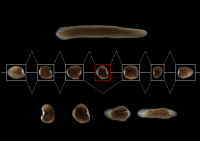 NEWS
NEWS
'Yin and Yang' Switch Lies at the Heart of Animal Stem Cells
PRESS RELEASE
A molecular switch that flips between different versions of genes could be crucial for maintaining stem cells across all animals from simple flatworms to humans, according to a study from scientists at the Centre for Genomic Regulation (CRG) in Barcelona, published today, in the journal eLife.
Flatworms (also known as planarians) have an incredible capacity for self-renewal, with almost any part of their body able to regenerate a whole new worm in a matter of days. In collaboration with Jordi Solana and Nikolaus Rajewsky and other colleagues from the Max Delbrück Center for Molecular Medicine in the Helmholtz Association (MDC) in Germany and the University of Toronto, CRG group leader Manuel Irimia studied the patterns of gene activity in stem cells in these unusual animals.
They found that they ‘mix and match’ certain parts of their genes in particular ways – a process known as alternative splicing*. The same analysis of flatworm cells that had changed (differentiated) into more specific cell types revealed a different mixture of gene parts.
Looking more closely, the team discovered that two families of molecules – CELF and MBNL – work as a kind of ‘yin and yang’ switch, enabling cells to flip between different patterns of alternative splicing. CELF molecules guide gene splicing patterns linked to self-renewal of stem cells, while MBNL factors favour differentiation.
The study builds on Irimia’s previous research showing that MBNL proteins and alternative splicing patterns are important in human and mouse embryonic stem cells as they differentiate into other cell types.
Previously, scientists have discovered certain proteins, known as transcription factors, that are important for maintaining embryonic stem cells in mammals. However, these particular molecules do not play the same roles in the stem cells of invertebrate organisms such as flatworms, which split off from the ancestors of mammals around 600 million years ago, suggesting that they are quite new in evolutionary terms.
“Discovering that this kind of alternative splicing mechanism exists across such a wide evolutionary range suggests that it is very ancient, and may be equally important as transcription factors for giving animal stem cells their unique properties” says Irimia. “Furthermore, understanding how this ‘yin and yang’ switch is flipped and activates particular patterns of alternative splicing could one day lead to more improved methods for generating and differentiating stem cells, which could be used be used for regenerative medicine.”
CRG and MDC are part of the EU-LIFE, an alliance of 13 top research centres in life sciences to support and strengthen European research excellence. Initiated in 2012, the alliance officially kicked off on the 29th of May 2013 at CRG Barcelona.
Notes to editor:
*Genes are the instructions used by cells to make protein molecules. However, this is not a straightforward list of instructions, and genes often contain several different options for certain parts. When a gene becomes active in a cell, it is ‘read’ into a related messenger molecule called RNA, containing the entire set of instructions. This is then cut up and pasted back together (spliced), to create the right set of instructions needed by that particular cell. By mixing and matching various parts of a gene for different purposes, known as alternative splicing, specific cell types can generate the exact instructions they require.
Reference:
Jordi Solana, Manuel Irimia, Salah Ayoub, Marta R. Orejuela, Vera Zywitza, Marvin Jens, Javier Tapial, Debashish Ray, Quaid D. Morris, Timothy R. Hughes, Benjamin J. Blencowe, Nikolaus Rajewsky.
“Conserved functional antagonism of CELF and MBNL proteins controls stem cell-specific alternative splicing in planarians.”
eLife, August 9, 2016.
Media contact until August 15:
Centre for Genomic Regulation (CRG) – Annick Labeeuw – annick.labeeuw@crg.eu – Tel. +34 93 316 02 37
Media contact from August 16 on:
Centre for Genomic Regulation (CRG) – Laia Cendrós – Press Officer – laia.cendros@crg.eu – Tel. +34 93 316 02 37
| Attachment | Size |
|---|---|
| 109.44 KB | |
| 112.16 KB | |
| 112.6 KB |

